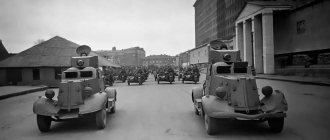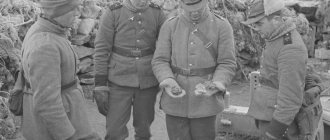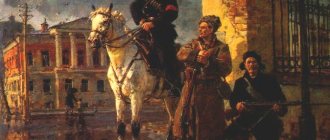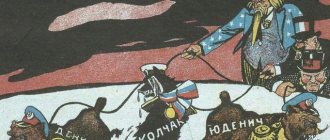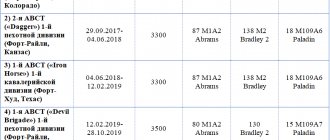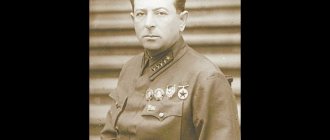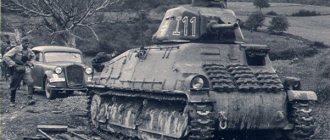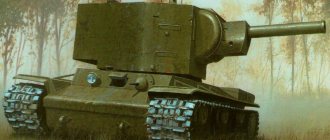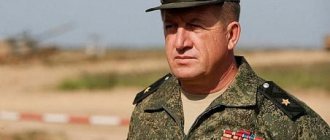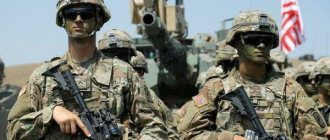| 1st Tank Army 1. Panzerarmee | |
| |
| Years of existence | 1940 — 1945 |
| A country | Third Reich |
| Type | tank army |
| View | Heer |
| Motto | |
| Participation in | Battle of Dubno-Lutsk-Brody (1941) |
| Commanders | |
| Notable commanders | Ewald von Kleist Eberhard von Mackensen Gotthard Heinrici |
This term has other meanings, see 1st Tank Army.
1st Tank Army
(German
1. Panzerarmee
) - tank army of the Wehrmacht during the Second World War.
Created on November 16, 1940 as the 1st Panzer Group
(German:
Panzergruppe 1
).
On October 6, 1941, it was renamed the 1st Tank Army. From January to May 1942 it was called the army group "Kleist"
(German:
Armeegruppe Kleist
).
In July 1944, the army group was called "Raus"
(German:
Armeegruppe Raus
).
In August-October 1944 and January 1945, the army group was called "Heinrici"
(German:
Armeegruppe Heinrici
).
Battle path
In April 1941, she took part in the Balkan campaign (the capture of Yugoslavia and Greece).
From June 22, 1941 - on the Eastern Front. By the beginning of the war, Ewald von Kleist's 1st Panzer Group had 880 tanks in 5 tank divisions. Including 265 PzKpfw II, 447 PzKpfw III and 168 PzKpfw IVК: Wikipedia: Articles without sources (type: not specified)[ source not specified 2735 days
]. As part of Army Group South, she participated in Operation Barbarossa. Fighting in Western Ukraine, in the area of Kyiv, in the area of Taganrog and Rostov-on-Don.
In 1942 there were battles in the Kharkov region, then in the Kuban and North Caucasus.
In 1943 there were battles in the Kharkov region, then on the Dnieper River.
In March 1944 - fighting in the Kamenets-Podolsk cauldron, with losses, the army broke through to Western Ukraine. In July 1944, she retreated to Slovakia.
In 1945 - fighting in the Czech Republic.
How a German tank group stumbled over British artillery
On February 14–24, 1943, in the battles of the Faid and Kasserine passes, Italian-German troops inflicted heavy losses on the 2nd US Army Corps, stopped the Allied advance towards the city of Tunis and threw them back to the west. Having won a tactical victory, Field Marshal Rommel decided to transfer his troops to the British 8th Army sector and defeat Montgomery. The transfer of Rommel's divisions was to be covered by General von Arnim, delivering a diversionary blow to the 5th British Corps. On February 26, the Lang tank group, which included more than 70 tanks, went on the offensive. The Germans planned to capture the important transport hub of Beja, but on the way to it lay the village of Sidi N'Sir, where infantrymen of the 5th Hampshire Battalion and the 155th Artillery Battery were entrenched. A fierce battle broke out and lasted twelve hours.
.
Operation Ochsenkopf
On February 22, 1943, the German counteroffensive at the Kasserine Pass was finally stopped - Field Marshal Erwin Rommel no longer had the strength to attack, and the Allies strengthened their defenses at Tebessa and Tala. On February 23, Rommel was appointed commander-in-chief of Army Group Africa, but the new position hardly pleased the German commander - further advance to the west was impossible. For the fact that the counteroffensive ended in failure, Rommel blamed the commander of the 5th Panzer Army, Colonel General Hans-Jürgen von Arnim, who did not transfer additional forces to him at the decisive moment. After the US 1st Armored Division was badly battered, Rommel planned to move troops east and attack the British 8th Army. Units of the 5th Tank Army were supposed to cover the retreat of the Desert Fox.
Meanwhile, General von Arnim tried not so much to cover Rommel's retreat as to move further to the west, pushing back parts of the 5th British Corps. The future offensive of the 5th Panzer Army received the code name "Ochsenkopf". One of the key objectives of this operation was to capture the important transport hub of Beja, as well as the city of Medjes al-Bab. Rommel approved the initial plan, but on February 24, while in Rome, von Arnim, together with Field Marshal Albert Kesselring, developed a more daring offensive plan, according to which the Italo-German troops would strike on a wider front and push the enemy to the Jebel Abiod-Beja line – Testur – El Aroussa. Kesselring convinced Rommel to leave the 10th and 21st Panzer Divisions near the city of Le Kef, although he initially intended to send them quickly against the British 8th Army.
Operation Ochsenkopf involved Corps Group "Weber" under Lieutenant General Friedrich Weber, which included five groups - "Battle Group Lang" of Colonel Rudolf Lang, "Battle Group Eder" of Oberst-Lieutenant (Lieutenant Colonel) Eder, "Battle Group Audorf" Oberst-Lieutenant (Lieutenant Colonel) Paul Audorf, "Combat Group Schmidt" Colonel Joseph Schmidt and the reserve group. The groups were assembled from disparate units, so sources indicate the composition of this improvised compound differently. Most likely, the composition of the Weber corps group was as follows:
"Battlegroup Audorf":
- 754th Grenadier Regiment, 334th Infantry Division;
- battalion of the Hermann Goering division.
"Combat Group Eder":
- 755th Grenadier Regiment, 334th Infantry Division.
"Combat Group Lang"
, which is often called
the "Lang tank group"
:
- headquarters of the 69th Panzergrenadier Regiment of the 10th Panzer Division;
- part of the 1st Battalion, 69th Panzergrenadier Regiment, 10th Panzer Division;
- 1st Battalion, 86th Panzergrenadier Regiment, 10th Panzer Division;
- 501st Tank Battalion;
- 26th African Battalion;
- 30 people from the squadron commander's support staff;
- a company from the guard of Field Marshal Kesselring's headquarters;
- 9th Battery, 90th Artillery Regiment, 10th Tank Division;
- two batteries of Nebelwerfer rocket launchers;
- air defense platoon;
- two 88 mm anti-aircraft guns;
- Italian artillery battery.
The group probably also included:
- 2nd Battalion, 7th Tank Regiment, 10th Tank Division;
- 10th Motorcycle Regiment, 10th Tank Division;
- sapper platoon;
- platoon of anti-tank guns.
"Combat Group Schmidt"
was a “hodgepodge” of various units, combined into three battle groups:
- "Battlegroup Kleberg":
- tank company from the 3rd battalion of the 7th tank regiment of the 10th tank division;
- 1st Battalion, 69th Panzergrenadier Regiment, 10th Panzer Division;
- 1st Battalion, 90th Artillery Regiment, 10th Tank Division;
- 2nd company of the 33rd African battalion;
- platoon of the 334th Engineer Battalion from the 334th Infantry Division.
- "Combat Group Koch":
- 2nd battalion from the Jäger Regiment of the Hermann Goering Division;
- 2nd Battalion, 190th Artillery Regiment, 10th Tank Division.
- "Battlegroup Holzinger":
- 756th Mountain Jaeger Regiment from the 334th Infantry Division;
- Tunisian field battalion T4 (Mikli battalion);
- 9th Battery, 90th Artillery Regiment, 10th Tank Division;
- 3rd Company, 334th Engineer Battalion, 334th Infantry Division;
- 2nd Battalion, 92nd Italian Infantry Regiment.
Reserve group
It consisted of:
- 47th Panzergrenadier Regiment, 21st Panzer Division;
- two infantry battalions of unknown origin.
In addition to these forces, Corps Group Weber was assigned Semovente da 75/18 assault guns from the Italian 553rd Group.
Most historians agree that the group consisted of 77 tanks, including 14 Tigers. According to the calculations of the British historian Brian Perret, the tank group consisted of 14 Tigers, 12 Pz.IV with long-barreled guns, 8 Pz.IV of old modifications and 40 Pz.III. US researcher Christopher Wilbeck gives different statistics: the 2nd battalion of the 7th tank regiment consisted of 8 Pz.IV and 24 Pz.III, the 501st heavy tank battalion - 14 Pz.VI, 12 Pz.IV and 15 Pz.III .
Lieutenant General Friedrich Weber. ww2talk.com
“Tank Group Lang” was supposed to capture the villages of Sidi N’Sir and Beja, “Group Eder” was to occupy height 688, turn south, defeat allied units in the mountains near the villages of Shaouash and Tukabir, and also cut the highway between Beja and Medjes-el -Babom (east of the village of Oued-Zarga). The "Audorf Group" struck south of Medjes el-Bab and then moved west. The "Schmidt Group" was supposed to attack Gubbelat, advance in the direction of Slughi and Oued Zarga, encircle the British units located at Medjes el-Bab from the south, turn north and meet the "Audorf Group", and then advance on Tebursuk and El -Arussu. To the north of the Weber Corps Group, a diversionary blow was delivered by the von Manteuffel division of Colonel Hasso von Manteuffel - it was supposed to break through the positions of the French African Corps in the Sejanan river valley and cut off communications leading from Jefna to Jebel Abiod. Von Arnim planned that the British would retreat to the west and would not be able to pursue Rommel's units, which would be transferred to the east.
In the sector of Operation Ochsenkopf there were parts of the 5th British Corps of Lieutenant General Charles Allfrey (from north to south): 46th (commander - Major General Harold Freeman-Attwood), 78th (commander - Major General Vivian Evele) and Special "Y" (commander - Brigadier Lyon Smith) infantry divisions. In addition, French units were transferred to the 138th Infantry Brigade of the 46th Division - the 3rd battalion of the 9th regiment of Algerian riflemen, the 3rd battalion of the 43rd regiment of colonial infantry and the 3rd regiment of Algerian riflemen. Units of the 139th Infantry Brigade of the 46th Division and two battalions of the French African Corps covered the road in the Sejanan Pass.
Scheme of Operation Ochsenkopf, February 1943. Rolf D. Bloody Road to Tunisia
Defenders of Sidi N'Sir prepare for battle
At 06:30 on February 26, Manteuffel's forces struck the Allied left flank. Over the next three weeks, the Germans captured Sejenana, Cape Serrat, Tamera and drove allied units to the west. Simultaneously with Manteuffel’s troops, the “corps group Weber” also went on the offensive. Its main blow fell on units of the 128th Infantry Brigade (46th Division), which covered the road leading to Beja. The 128th Brigade was led by an experienced combat officer, Brigadier Manly James, a veteran of the First World War.
On the way of the Germans there was a small village of Sidi N'Sir, which lay in the valley of the Bou Ouissa River at the junction of the highway leading to the city of Tunis and the railway connecting Matir and Beja. Standing out among the grassy limestone hills was Hill 609 (Jebel Takhent), located two miles northeast of the village. The terrain in the Matira area was clearly visible from the height, so British artillery spotters were stationed there.
Directly near the village, the defense was occupied by the 5th Battalion (commanded by Lieutenant Colonel Horatio Newnham) of the Hampshire Infantry Regiment, supported by Major John Rowworth's 155th Battery (172nd Field Artillery Regiment) consisting of eight 25-pound howitzers. The 155th battery consisted of 130 people, including nine officers. This modest force was the covering force for the 128th Brigade, as the main part of it (1st and 2nd Battalions of the Hampshire Infantry Regiment) was concentrated in a long defile east of Ksar Mezuar station - this area was called "Hunt's Pass" by the British.
Newnham's battalion was supposed to conduct reconnaissance, in the event of an enemy attack, be the first to take the fight and gain time so that the main forces of the brigade had time to prepare for defense. British sappers mined the road to the village, but the infantrymen were sorely lacking in anti-tank weapons, since the 2-pounder guns were not suitable for fighting the later modifications of the Pz.III and Pz.IV, and especially the Tigers. 25-pound howitzers were not an anti-tank panacea either; moreover, the artillerymen had to perform two functions - supporting their infantry with fire and fighting enemy tanks. Lieutenant Colonel Newnham had great difficulty in supplying his battalion and the attached artillery, and also had to take care of the defense of the hills surrounding the village.
The battalion headquarters, under cover of a 2-pounder gun and anti-aircraft machine guns, were located in and around the railway station building. Company C took up positions on the hills west of the railroad, with one platoon covering the observation post of Squad E of the 155th Battery two miles north of the village (among the huts of the village of Sidi Bana). Company A, with two 3-inch mortars and a Vickers machine gun, took up positions half a mile northeast of the station and was covered from the rear by minefields. B Company, with two mortars and a 2-pounder, held the long ridge south of the road leading to Matir. Company "D" (also with two mortars and a gun) occupied a defensive position 700 m east of the station (north of the highway). The guns of the 155th Battery were positioned to the east of D Company: F Section occupied positions to the left of the road leading out of Matira; department "E" - to the right of the road (in the field), 270 m behind department "F". Sergeant Robert Henderson's No. 1 (Squad F) gun was the closest to the road. At Hill 609 there were spotters from Section F of the 155th Battery, who were covered by a platoon of infantry. The battalion's transport and batteries were located four kilometers south of Sidi N'Sir, towards the "Hunt's Pass" at the so-called "Hampshire Farm".
First fights
At dawn on February 22, B Company sent a group of soldiers to the hill south of the Matir road to take control of it. Along the way, the British infantry met German scouts, killed one of them and captured two. Instead of carrying out the task, the British returned to battalion headquarters and brought prisoners. When a platoon from Company B attempted to reach the hill at 9:00 a.m., it came into contact with the enemy. Explosions and shooting were heard at the headquarters, and no one from the platoon returned. At 11:00 the right flank of Company B came under mortar fire. The British returned fire and the enemy withdrew. On this day, Lieutenant Colonel Newnham received orders to withdraw to "Hunt's Pass", leaving two howitzers and one infantry company near the village. Newnham disputed the order, arguing that such a small force would be destroyed by the corvids in one blow. Brigadier James canceled the order for the main body of the 5th Battalion to withdraw and sent A Company of the 1st Battalion to assist Newnham, which took up positions on the right flank of the 5th Battalion (two miles south of B Company).
Until February 25, no incidents were noted at Sidi N'Sir, the enemy did not appear, the commander of the 46th division and the commander of the 172nd artillery regiment, Lieutenant Colonel William Graham, arrived in the village. The officers visited Hill 609 and did not notice any enemy movements. On 25 February German aircraft were active, strafing any British vehicles spotted and patrolling the road to Matir. On the same day, British aerial reconnaissance reported that a large mass of German tanks and infantry was approaching Sidi N'Sir from the east. The British were also alarmed by the fact that local shepherds had removed their flocks from the hills near the village, and on the morning of February 26, the head of the railway station and his family took refuge in the basement. The Arabs probably knew about the approach of German troops, having received information from their fellow tribesmen, but not wanting to warn the British.
The village was to be captured by units of the Lang tank group. From the south they were supported by units of the 755th Grenadier Regiment (Eder Group), which intended to advance in a north-easterly direction to Oued Zargah and cut the main road leading to Medjes el-Bab. The Lang Group documents indicate that the 501st Battalion (commanded by Major Hans Georg Lüder) of the 7th Panzer Regiment crossed the starting line on February 26 at 5:00. Colonel Lang claimed that the road was heavily mined, and the stopped tank vanguard blocked the advance of the entire column. The Germans came under heavy artillery fire, and their sappers were unable to clear the road due to heavy machine gun fire from the flanks. For Lang, the situation was complicated by the fact that his soldiers were exhausted from previous battles (at Tebessa), the reconnaissance of the area was poor, and the 47th Grenadier Regiment was still on the march.
At 6:30 the Germans covered Hill 609 with mortar fire and continued moving along the road. At approximately 7:05 the first German tank hit a mine (according to another version, it was a Semovente self-propelled gun). The crew tried to leave the car, but were shot by British machine gunners. Meanwhile, the howitzers of Squad F opened fire on eight tanks (including three Tigers) and trucks carrying infantry. One Pz.III was burned by Sergeant Henderson's gun from a distance of 180 m. After two more tanks were knocked out, the Germans retreated. At 09:30, the howitzers of Squad "F" were running out of shells, and the gunners began carrying shells from the positions of Company "E" under fire.
Scheme of the battle for the village of Sidi N'Sir. ww2talk.com
Lieutenant Colonel Newnham climbed the hill occupied by D Company and watched the battlefield. The Germans brought artillery fire down on the positions of Companies A and D. The British were also attacked by German fighters - eight Bf.109s circled over the battlefield, firing primarily at vehicles spotted on the road leading to “Hunt’s Pass.” As a result of the raids, several Universal Carrier armored personnel carriers (including those loaded with ammunition) were destroyed. Two planes were shot down using anti-aircraft machine guns and other small arms. Returning to his headquarters, Newnham contacted brigade headquarters and asked for an aerial reconnaissance of the road to Matir. The brigade headquarters reported that at the moment aerial reconnaissance is impossible due to the active actions of enemy aircraft.
At 9:40, German infantry attacked Hill 609. A platoon of British infantry under the leadership of Lieutenant Heath was able to hold out until 10:30. At the same time, two companies of Germans attacked the Sidi Bana hill, where soldiers under the leadership of Lieutenant Amos were fighting. Having a numerical advantage of 6 to 1, the Germans captured the heights.
The Germans surround the village
Around 11:00 the Germans attacked the British left flank, but F Squad's guns knocked out four tanks. At 11:45 am, the defenders of Sidi N'Sir were supported by the guns of the 5th Medium Regiment of the Royal Artillery, under the command of Lieutenant Geoffrey Stavert, who took up positions in "Hunt's Pass". At that moment, a group of eight German tanks broke through the farthest - dense artillery fire forced them to retreat, although not a single one of the vehicles was hit. Soon, communication between Sidi N'Sir and the 5th Regiment was severed.
At 12:40, the Germans assembled a strike group of thirty tanks and four self-propelled guns and began to move around the British on two flanks simultaneously. German tanks had to advance along a narrow valley, with no room for maneuver. Trying to break through the British positions, Lang was forced to bring more and more tanks into battle. By the afternoon, German infantry was able to capture the main observation post of the British artillerymen and destroyed the radio transmitter. In addition, the Germans managed to cut the Sidi N'Sir - Beja road and interrupt the telephone connection of the 5th battalion with the brigade. Having come to the rear of the British artillerymen, the Germans opened machine-gun fire on them. The British infantry launched a counterattack and destroyed several enemy machine gun crews. In the afternoon, the Germans began to tighten the ring around the village, capturing the hills on its outskirts.
At 14:00, three tanks (a Tiger and two Pz.IV) were able to break through the southern edge of the minefield, but came under fire from the howitzers of squad F. All three tanks were disabled.
Pz.IV from the Lang tank group at Sidi N'Sir. ww2talk.com
Meanwhile, German infantry broke through the gap between the positions of Company B of the 5th Battalion and Company A of the 1st Battalion (3 km west of the Sidi N'Sir - Beja road), and at 15:00 cut off the village from the ammunition depot and transport bases located at Hampshire Farm. The British artillerymen were left with a meager supply of shells, and the Germans began to prepare for a decisive attack. As Colonel Lang reported, great success was achieved by the 1st Battalion of the 86th Panzergrenadier Regiment under the command of Captain Erich Hauth. His grenadiers bypassed Hill 609 from the west, broke through to the Sidi N'Sir - Ksar Mezoir road, cut it and blocked the British from the south. After this there was a short lull.
Death of the 155th battery
After 16:00 the Germans resumed their offensive. The commander of B Company, Lieutenant John Little, informed Lieutenant Colonel Newnham that he had only 30 men left. Soon after this, contact with Company B was lost. Thirteen German tanks attacked Section F from the south. “Sergeant Henderson’s gun hit the leading tank with the first shot. The crew of the German vehicle died from a direct hit from a shell."
, reports the 46th Infantry Division.
High-explosive shells exploded at the artillerymen's positions, the distance between howitzers and tanks was reduced to 30-40 m. In such a difficult situation, Lieutenant Taylor acted bravely, who, under enemy fire, brought shells to the guns and provided assistance to the wounded. First, the tanks shot down three guns of squad “F”, then began to destroy the rest. Lieutenant Stavert witnessed the death of Squad F:
“Tank towers appeared along the crest of the height, and a strong roar was heard - both howitzers and tank guns were hitting. A series of small holes appeared on the top of the shield of gun No. 3. The sergeant shouted to his men to keep their heads down. The gunners reloaded the gun and the howitzer fired. The shell hit the Tiger's forehead and simply bounced off. Gun No. 4 was out of action, and crew members lay around it. The gunner of gun No. 2 collapsed to the ground, his ankles shot. But some tanks burned like candles, sending clouds of black smoke upward. A direct hit on gun No. 4 folded his shield in half like wet paper.”
As a result, only one howitzer remained in service, which fired from a distance of 10–15 m. During this battle, British artillerymen disabled seven tanks. Having defeated squad “F”, the Germans surrounded squad “E” - their tanks began to iron the trenches in which the artillerymen had taken refuge, walked through the positions of infantry company “D” and headed towards the railway station. At approximately 18:00, four German tanks began shelling the station building, and Lieutenant Colonel Newnham, realizing that further resistance was pointless, gave the order to retreat.
The Germans occupy the village
Companies “A”, “B” and “D” of the 5th battalion were destroyed, and two Pz.IVs came close to the station building. The 2-pounder gun managed to fire one shot and was immediately destroyed. To the west of the station, soldiers of Company C continued to hold the defense. German tanks began to fire at the building, but the tankers were afraid to approach it because they saw barbed wire barriers and thought that the territory was mined. In the dark, the British planted time bombs at the station, burned their personal belongings, and destroyed radio codes and maps. The remnants of the 5th battalion and the 155th battery began to retreat to Hampshire Farm.
German soldiers inspect British prisoners of war, village of Sidi N'Sir, evening of February 26, 1943. ww2today.com
At approximately 21:30, Newnham and a group of fighters reached the farm, unaware of the fate of their companies. In the distance, in the sector of the village, he saw the glow of fires and flashes of explosions. At 08:00 on 27 February, Newnham and his men reached the 2nd Battalion's position. Here the lieutenant colonel learned that an hour earlier than him, the remnants of Company C and Company A of the 1st Battalion had arrived at Hunt’s Passage. During 27 February, several more small groups of Sidi N'Sir defenders made their way here, including Lieutenant Robert Pemberton, who arrived with 24 men from D Company, and Captain Bormond with 9 gunners from the 155th Battery (7 of them were wounded). In total, no more than 200 soldiers of the 5th battalion managed to escape from the encirclement.
In battles with British infantrymen and artillerymen, more than 20 German tanks were damaged, including 2 Tigers (however, repair teams restored the lion's share of damaged vehicles). The British claimed that they were able to destroy up to ten tanks, while the Germans confirmed the irretrievable loss of only a few vehicles (including Pz.III and Semovente). Additionally, the British claimed to have destroyed over 200 German infantry and several trucks and armored personnel carriers, which is likely an exaggeration. In turn, Colonel Lang claimed that several hundred British troops were captured at Sidi N'Sir, and the Germans destroyed or captured 25 guns. However, having achieved local success, the Lang tank group lost the main thing - time, and was unable to quickly take possession of Beja.
The collapse of the "Tank Group Lang"
The offensive towards the “Hunt Pass” began on February 27 - since it rained all night, the dirt road was wet, and the Germans experienced considerable difficulties in moving armored vehicles and artillery. Field Marshal Rommel commented on the offensive of the Italo-German troops:
“The Allied forces soon launched fierce counterattacks, but rainy weather became a major hindrance to the attacking troops using heavy weapons. The offensive lasted several days. We hoped for at least limited success, but the losses of the German-Italian troops turned out to be much greater than the losses of the enemy. In no sector did the offensive develop as envisaged in our, as it seemed to us, well-thought-out tactical plan. As a result, we wasted our energy and people. Most of the tanks got stuck in the mud, the rest of the combat vehicles were neutralized by enemy fire.”
While Lang was trying to break through the British defenses at Sidi N'Sir, the 2nd Battalion of the 4th Hampshire Regiment and the 2nd Battalion of the Leicestershire Regiment (139th Brigade) arrived at Hunt's Pass. Here the British assembled a powerful “artillery fist” - the 171st and 172nd (minus one battery) field artillery regiments, a battery of the 102nd field artillery regiment, the 58th anti-tank regiment and five medium artillery regiments, which included, among other artillery systems, there were seventy-two 25-pound howitzers and fifteen 5.5-inch guns. In addition, two squadrons of the Northern Irish Cavalry Regiment (12 Churchill tanks) approached the “Hunt Pass”.
Scheme of the advance of the 501st heavy tank battalion during Operation Ochsenkopf. Wilbeck C. Sledgehammers: Strengths and Flaws of Tiger Tank Battalions in World War II. – Dallas: Aberjona Press, 2004
On the morning of February 28, ten Pz.IVs, supported by infantry, attacked B Company of the 2/4th Hampshire Regiment, but the Churchills knocked out four German tanks and the attack was repulsed. The Germans launched several more attacks, but the tanks, moving along the narrow roads, made excellent targets for the British artillerymen. On March 1, weather conditions improved and the German columns were attacked by Hurricane fighters. Lang stopped 16 km from the “Hunt Pass” and was unable to advance further, since he had only six combat-ready tanks left. According to the German historian Wolfgang Schneider, on February 28, seven Tigers were blown up by mines, Major Lüder, Lieutenants Kodar, Hartmann and Stockhammer were injured. As of March 1, only one Tiger remained in service.
On March 2, the Germans began to retreat, abandoning faulty equipment. On 5 March the 2/4th Hampshire Battalion, having suffered 243 casualties between 26 February and 4 March, was withdrawn to the rear and relieved by the 8th Battalion of the Argyll and Sutherland Highlanders (36th Brigade).
German tanks destroyed at the Hunt Pass. ww2talk.com
The battle groups Eder, Audorf and Schmidt also failed to complete their assigned tasks. The Eder group cut the Medjes el-Bab-Beja road, but never captured Medjes el-Bab itself. Units of "Audorf" managed to capture the heights of Jebel Jaffa, but the British threw tank reserves into battle and, pouring hurricane artillery fire on the enemy, recaptured it. Group "Schmidt" did not capture El Arussa, came under a counterattack by the British division "Y" and suffered heavy losses (as, in fact, all groups participating in the operation).
At the beginning of March, it became obvious that Operation Ochsenkopf had failed - the Germans were unable to take Medjes el-Bab and Beja. During the counter-offensive, the “Weber corps group” lost about a thousand soldiers and officers killed, the total loss of personnel exceeded 4,500 people. According to German data, 7 Tigers, 8 Pz.IV, 19 Pz.III were destroyed, over 30 vehicles were out of action, most of the artillery was abandoned; the Allies estimated the total losses of German armored vehicles at 71 units. In turn, the Germans captured more than 2,500 enemy soldiers and officers (total Allied losses exceeded 4,200 people), destroyed or captured 20 tanks, over 37 guns, 40 vehicles, and 7 aircraft.
The failure of Operation Ochsenkopf had dire consequences for the Italo-German forces in North Africa. Firstly, the Germans lost a large number of tanks, which they could not replace, and secondly, due to the fact that parts of the 10th Panzer Division were involved in the operation, Rommel postponed the offensive against the 8th British Army for a whole week. The Germans lost the element of surprise and strategic initiative - if at the end of February 1943 Montgomery could field only one division against them, by March 6 the British forces had quadrupled. Rommel's subsequent offensive at Medenine ended in failure, and one of the main reasons for this was the failure of Operation Ochsenkopf.
The author expresses gratitude to Vadim Antonov for his assistance in working on the article.
Literature:
- Moshchansky I. German-Italian combat operations. 1941–1943 – Moscow: Veche, 2011
- Rolf D. Bloody Road to Tunisia. – Moscow: AST, Ermak, 2003
- Howe G. United States Army in World War II: Northwest Africa: Seizing the Initiative in the West. – Washington: Center of Military History, 1993
- Liddell-Hart B. The Rommel Papers. – New York: Da Capo Press, 1982
- Perret B. Last Stand! Famous Battles Against the Odds. – London: Hachette, 2012
- Schneider W. Tigers in Combat, Vol. 1. – Mechanicsburg: Stackpole Books, 2007
- Watson W. Exit Rommel: The Tunisian Campaign, 1942–43. – Mechanicsburg: Stackpole Books, 2006
- Wilbeck C. Sledgehammers: Strengths and Flaws of Tiger Tank Battalions in World War II. – Dallas: Aberjona Press, 2004
Combat composition
In March 1941:
- 40th Army Corps (motorized)
- 30th Army Corps
- 18th Mountain Corps
In June 1941:
- 3rd Army Corps (motorized): consisted of the 13th, 14th tank divisions and 25th motorized division
- 14th Army Corps (motorized): consisted of the 9th Panzer Division, as well as two elite SS motorized divisions "Wiking" and "Leibstandarte Adolf Hitler"
- 48th Army Corps (motorized): consisted of the 11th, 16th Tank and 25th Infantry Divisions
- 29th Army Corps (Wehrmacht): consisted of the 299th and 44th Infantry Divisions
- There was also a reserve consisting of the 16th Motorized Division.
In November 1941:
- 3rd Army Corps (motorized)
- 14th Army Corps (motorized)
- 49th Mountain Corps
In September 1942:
- 3rd Tank Corps
- 40th Tank Corps
- 52nd Army Corps
In August 1943:
- 40th Tank Corps
- 57th Tank Corps
- 30th Army Corps
In March 1944:
- 3rd Tank Corps
- 24th Tank Corps
- 46th Tank Corps
- 59th Army Corps
In September 1944:
- 24th Tank Corps
- 11th Army Corps
- 1st Hungarian Army
Notes[edit]
- Nipe 2012.
- Battistelli 2012, p. 11
- Sheppard, Alan (1990). France, 1940: Blitzkrieg in the West
. Oxford: Osprey. p. 81. ISBN 978-0-85045-958-6. - Jump up
↑ Mitcham 2006, p. 258 - ^ a b Ziemke 2002, p. 17.
- Ziemke 2002, pp. 18-19.
- Ziemke 2002, pp. 19, 3-4.
- Ziemke 2002, p. 71.
- ^ a b Ziemke 2002, p. 85.
- Ziemke 2002, pp. 86, 85.
- Ziemke 2002, pp. 94-96.
- Ziemke 2002, p. 138.
- Ziemke 2002, pp. 184-185.
- Ziemke 2002, p. 280.
- Ziemke 2002, p. 282.
- Ziemke 2002, p. 286.
- Ziemke 2002, p. 359.
- Jump up
↑ Raus 2003, p. 353.
Commanders
- Colonel General Ewald von Kleist, November 16, 1940 - November 21, 1942
- Colonel General Eberhard von Mackensen, November 21, 1942 - October 29, 1943
- Colonel General Hans-Valentin Hube, October 29, 1943 - April 21, 1944
- General of Infantry Kurt von der Chevalery, April 21 - May 18, 1944
- Colonel General Erhard Routh, May 18 - August 15, 1944
- Colonel General Gotthard Heinrici, August 15, 1944 - March 19, 1945
- Panzer General Walter Nehring, March 19, 1945 - May 8, 1945
The beginning of hostilities of the 2nd Panzer Division on the Eastern Front as part of Army Group Center
In September 1941, the 2nd Tank Division, having received new weapons and equipment, was transferred to the Eastern Front. On September 14-16, units of the division were unloaded from the trains in Smolensk. The city was still burning. The weather was cold. Units of the division moved under their own power through Bobruisk and Chernigov to Roslavl on the Desna River, where the division's starting area was before the attack on Moscow according to the plan for Operation Typhoon ("Unternehmen Taifun").
The 2nd Panzer Division for the attack on Moscow became part of the XXXX Motorized Army Corps (XXXX.Armeekorps mot.) of Cavalry General Georg Stumme of the 4th Panzer Group (4. Panzergruppe) of Colonel General Erich Hoepner. Army Group Center (HG “Mitte”) under the command of Field Marshal Fedor von Bock.
The attack on Moscow began at 6:15 am on October 2. The 2nd Panzer Division began an offensive east of Roslavl in a northeast direction. Powerful artillery fire and dive bomber attacks allowed the motorized infantry of the 2nd Panzer Division to seize a bridgehead on the other side of the Desna River. Then the sappers of the 38th Sapper Battalion quickly built a pontoon bridge, across which tanks, artillery and other units of the division crossed to the other side of the river. Units of the division moved forward, overcoming anti-tank barriers, water-filled ditches, fortifications built in hilly terrain, and repelling Soviet counterattacks from large forests.
On October 3, the 2nd Combat Group of the 2nd Tank Division, which included the 1st Battalion of the 3rd Tank Regiment and a rifle regiment, marched in a column through the village of Obolovka in a northerly direction to the village of Ponizovye. The column was met with fire from the forest 500 meters north of Obolovka by a anti-tank battery and the 1st regiment of the Soviet 17th Infantry Division. The 2nd combat group was forced to retreat to Obolovka, leaving 4 burning tanks on the battlefield. These were the first tank losses of the 2nd Panzer Division on the Eastern Front.
On the night of October 4, the battle for Obolovka took place, and in the afternoon the 2nd Tank Division broke through the Soviet defenses and moved to the northeast. On October 5, the division entered Yukhnov, after which it turned northwest, to Vyazma. On October 7, the 7th and 10th Tank Divisions closed the encirclement ring around the Soviet troops amassed west of Vyazma. The left flank of the 10th Panzer Division was covered by the 2nd Panzer Division, repelling counterattacks by Soviet units of the Western Front retreating to the east.
The position of the parties in the area of the Vyazemsky cauldron on October 7, 1941.
The 2nd Panzer Division and the entire XXXX Army Corps remained in the Vyazma area for another week, preventing the encircled Soviet troops from retreating from the “cauldron” to the east. Until October 14, attempts by Soviet units to break out of the “cauldron” continued. The commander of the 304th Infantry Regiment of the 2nd Panzer Division, Lieutenant Colonel Hans-Ulrich Back, led a battle group that cleared the forest near Vyazma and took prisoners.
On October 12, the 2nd Panzer Division transferred to the XXXXVI (46th) Motorized Army Corps under the command of Panzer General Heinrich von Vietinghoff of the 4th Panzer Group.
On October 15, the 2nd, 5th and 11th Panzer Divisions of the XXXXVI Motorized Corps moved towards Moscow. The 2nd Panzer Division advanced behind the 11th Panzer Division along the Smolensk-Moscow railway and entered Gzhatsk on October 15.
For the offensive, several battle groups were formed in the 2nd Panzer Division. Battlegroup Decker was commanded by the commander of the 3rd Tank Regiment, Lieutenant Colonel Karl Decker. Combat Group Bak was commanded by the commander of the 304th Infantry Regiment, Colonel Hans-Ulrich Back.
On October 17, the vanguard of the 2nd Panzer Division, following the 11th Panzer Division along the highway, reached Porechye. Divisions of the XXXXVI Motorized Corps approached the Volokolamsk fortified area of the outer Moscow defensive line (Mozhaisk defensive line), which ran from Kaluga through Mozhaisk and Volokolamsk to the Moscow-Volga canal.
Hundreds of thousands of Moscow workers, mostly women, built several new defensive lines of the Moscow Defense Zone. Pillboxes, bunkers, minefields, anti-tank ditches, scarps and counter-scarps, gouges and wire fences blocked all paths to Moscow. Some Soviet anti-tank mines had a wooden body. German sappers could not detect them, and many German tanks were blown up on them, sometimes overturning.
On October 17, the 2nd Tank Division began breaking through the Mozhaisk defense line in the Porechye-Fedosino sector. On October 18, the division advanced to the left of the 11th Tank Division and bypassed from the south the extended left flank of the Soviet 316th Infantry Division of Major General I.V. Panfilov of the 16th Army of Lieutenant General K.K. Rokossovsky. On October 19, units of the division approached the village of Ostashevo from the south.
In the battles from October 16 to 19, the 2nd Panzer Division suffered heavy losses. On October 19, the car of the commander of the 3rd Tank Regiment, Lieutenant Colonel Dekker, ran into an anti-personnel mine while driving across a field. Dekker was slightly wounded, but remained in service.
On October 18, heavy rains began. On October 19 thaw began. Trucks, cars, motorcycles and other wheeled vehicles could not move due to deep mud. Even tanks and other tracked vehicles could move with great difficulty. The division's advance slowed. The food supply for personnel has deteriorated. Its basis was crackers and processed cheese.
From the combat log of Army Group Center headquarters dated October 19: “ On the night of October 18-19, it rained along the entire front of Army Group. The condition of the roads deteriorated so much that a severe crisis arose in the supply of troops with food, ammunition and especially fuel. The condition of the roads, weather and terrain conditions significantly delayed the progress of military operations. The main concern of all formations is the supply of logistics and food
».
On October 20, the 2nd Panzer Division suspended its offensive and went on the defensive. On October 23, the division turned north and approached Volokolamsk from the south.
On October 24, the German offensive continued. Baka's battle group made several unsuccessful attempts to take Volokolamsk from the south. On October 25, the 2nd Tank Division and the 35th Infantry Division, which was advancing on the city from the west, launched an attack on the city of Volokolamsk from two directions. After powerful artillery bombardment and dive bomber attacks, the tanks and motorized infantry of the 2nd Tank Division went on the offensive near the village of Spas. Units of the 2nd Tank Division attacked on a narrow section of the front the positions of the 1075th Regiment of the 316th Infantry Division of Major General I.V. Panfilov and the 289th Anti-Tank Artillery Artillery. By the end of the day, units of the 2nd Tank Division reached the Volokolamsk station, 2 km south of the city of Volokolamsk.
On the morning of October 27, units of the 2nd Panzer Division managed to break through to the western outskirts of the city. The fighting on the city streets lasted about 3 hours. By evening, German troops captured Volokolamsk. The front was stabilized 4 kilometers east of Volokolamsk with the help of the 50th Cavalry Division of Major General I. A. Pliev and additional artillery units.
Literature
- James Lucas: Die Wehrmacht 1939-1945. Zahlen, Daten, Fakten. Tosa Verlagsgesellschaft, Wien 2004, ISBN 3-85492-880-7
| Army | |
| tank: |
|
| parachute: | |
- "Reich"
| army: |
|
| motorized: | |
| tank: |
|
| mountain: |
|
| cavalry: |
|
| reserve: | |
| policemen: | |
| aviation: |
|
| parachute: |
|
| army: |
|
| infantry: |
|
| grenadier: |
|
| Volksgrenadier: |
|
| mountain rifle: |
|
| huntsman: |
|
| lungs: |
|
| cavalry: |
|
| parachute: |
|
| airfield: | |
| security: |
|
| Marine Corps: |
|
| reserve: |
|
| SS troops: |
|
| fighter-bombers: |
|
| night fighters: |
|
Excerpt characterizing the 1st Panzer Army (Wehrmacht)
The more he, in those hours of suffering solitude and semi-delirium that he spent after his wound, thought about the new beginning of eternal love that had been revealed to him, the more he, without feeling it himself, renounced earthly life. Everything, to love everyone, to always sacrifice oneself for love, meant not loving anyone, meant not living this earthly life. And the more he was imbued with this principle of love, the more he renounced life and the more completely he destroyed that terrible barrier that, without love, stands between life and death. When, at first, he remembered that he had to die, he said to himself: well, so much the better. But after that night in Mytishchi, when the one he desired appeared in front of him in a semi-delirium, and when he, pressing her hand to his lips, cried quiet, joyful tears, love for one woman imperceptibly crept into his heart and again tied him to life. Both joyful and anxious thoughts began to come to him. Remembering that moment at the dressing station when he saw Kuragin, he now could not return to that feeling: he was tormented by the question of whether he was alive? And he didn't dare ask this. His illness took its own physical course, but what Natasha called: this happened to him happened to him two days before Princess Marya’s arrival. This was the last moral struggle between life and death, in which death won. It was the unexpected consciousness that he still valued the life that seemed to him in love for Natasha, and the last, subdued fit of horror in front of the unknown. It was in the evening. He was, as usual after dinner, in a slight feverish state, and his thoughts were extremely clear. Sonya was sitting at the table. He dozed off. Suddenly a feeling of happiness overwhelmed him. “Oh, she came in!” - he thought. Indeed, sitting in Sonya’s place was Natasha, who had just entered with silent steps. Since she began following him, he had always experienced this physical sensation of her closeness. She sat on an armchair, sideways to him, blocking the light of the candle from him, and knitted a stocking. (She learned to knit stockings since Prince Andrei told her that no one knows how to take care of the sick like old nannies who knit stockings, and that there is something soothing in knitting a stocking.) Thin fingers quickly fingered her from time to time the clashing spokes, and the pensive profile of her downcast face was clearly visible to him. She made a movement and the ball rolled off her lap. She shuddered, looked back at him and, shielding the candle with her hand, with a careful, flexible and precise movement, she bent, raised the ball and sat down in her previous position. He looked at her without moving, and saw that after her movement she needed to take a deep breath, but she did not dare to do this and carefully took a breath. In the Trinity Lavra they talked about the past, and he told her that if he were alive, he would forever thank God for his wound, which brought him back to her; but since then they never spoke about the future. “Could it or could it not have happened? - he thought now, looking at her and listening to the light steel sound of the knitting needles. - Was it really only then that fate brought me so strangely together with her that I might die?.. Was the truth of life revealed to me only so that I could live in a lie? I love her more than anything in the world. But what should I do if I love her? - he said, and he suddenly groaned involuntarily, according to the habit that he acquired during his suffering. Hearing this sound, Natasha put down the stocking, leaned closer to him and suddenly, noticing his glowing eyes, walked up to him with a light step and bent down. - You are not asleep? - No, I’ve been looking at you for a long time; I felt it when you came in. No one like you, but gives me that soft silence... that light. I just want to cry with joy. Natasha moved closer to him. Her face shone with rapturous joy. - Natasha, I love you too much. More than anything else. - And I? “She turned away for a moment. - Why too much? - she said. - Why too much?.. Well, what do you think, how do you feel in your soul, in your whole soul, will I be alive? What do you think? - I'm sure, I'm sure! – Natasha almost screamed, taking both his hands with a passionate movement. He paused. - How good it would be! - And, taking her hand, he kissed it. Natasha was happy and excited; and immediately she remembered that this was impossible, that he needed calm.
The last attack on Moscow in November-December 1941
On November 4, early frosts struck and it began to snow. The winter of 1941-1942 began early. The thaw ended and ice began to fall. German equipment could now move. The command of Army Group Center regrouped its troops and was able to raise reserves for the last attempt to encircle Moscow.
On November 11, the 2nd Panzer Division became part of the V Army Corps of the 4th Panzer Group and fought defensive battles until November 14. The corps also included the 35th and 106th infantry divisions. The V Army Corps was commanded by Infantry General Richard Ruoff.
The commander of the V Army Corps, General of Infantry Richard Ruoff (left), and his chief of staff, Colonel Hans Röttiger (center), talk with a wounded Signal Corps soldier, November 1941.
Bundesarchiv, Bild 101I-214-0342-36A. Photo: Geller
The 3rd and 4th tanks were to advance on Klin and Solnechnogorsk and bypass Moscow from the north. The 2nd Tank Group advanced bypassing Tula towards Kashira and Kolomna, bypassing Moscow from the south. The 4th Field Army had the task of pinning down the troops of the Western Front in the center. The decisive offensive of German troops on Moscow began on November 15-18.
The position of the parties on the central sector of the Eastern Front at the beginning of the last offensive on Moscow on November 15, 1941.
On November 16, the 2nd Panzer Division went on the offensive with the task of improving positions for the entire V Army Corps offensive planned for November 18. An auxiliary attack was carried out to the north by the 35th Infantry Division. The 2nd Tank Division, with two battle groups, attacked the positions of the Soviet 316th Infantry Division, Major General I.V. Panfilov, southeast of Volokolamsk in the area of the Dubosekovo railway crossing. The 1st combat group advanced on the right flank of the division east of Dubosekovo through Shiryaevo and Petelino to Lystsevo. The 2nd combat group advanced on the left flank west of Dubosekovo through Nelidovo, Bolshoye Nikolskoye and Yadrovo to Mykanino and Rozhdestveno. By mid-day on November 16, combat groups broke through the Soviet defenses and bypassed Volokolamsk from the east.
On November 16, events took place at the Dubosekovo crossing, which are known as the feat of 28 Panfilov heroes. The crossing was defended by the 4th company of the 2nd battalion of the 1075th Infantry Regiment under the command of Captain P. M. Gundilovich and political instructor V. G. Klochkov. Out of 140 people, only 25 soldiers, led by a company commander, survived. More than 100 people died in the 4th Rifle Company during the day. On November 16, the 1075th Infantry Regiment knocked out and destroyed 9 German tanks, some of which were blown up by Red Army soldiers of the 4th company with grenades.
The 1075th Infantry Regiment of the 316th Infantry Division was destroyed. On the morning of November 16, there were 1,534 people in the regiment. In two days of fighting, the regiment lost 400 people killed, 100 wounded and 600 missing.
Breakthrough of the battle groups of the 2nd Tank Division through the battle formations of the 1075th Regiment of the 316th Infantry Division near Volokolamsk on November 16-17, 1941.
Combat operations of the 1st (red) and 2nd (blue) combat groups of the 2nd Panzer Division in the Nelidovo - Dubosekovo - Shiryaevo sector. The dotted lines indicate the front lines on the evening of the 15th (pink), 16th (purple) and 17th (blue) November.
On November 17, units of the 2nd Tank Division expanded the breakthrough of the Soviet defense east of Volokolamsk. The 7th company of the 2nd rifle regiment of the 2nd tank division took Golubtsovo in battle.
On November 18, the 2nd Tank Division launched its final attack on Moscow from the area east of Volokolamsk. Tanks of the 3rd Tank Regiment with motorized infantry reached the headquarters of the Soviet 316th Infantry Division, which was located in the village of Gusenevo. On this day, the commander of the 316th division, Major General I.V. Panfilov, was killed by fragments of a German mortar mine. On November 19, units of the 2nd Infantry Regiment captured the village of Lyublyatino.
Having broken through the defenses of the Soviet troops, the 2nd Tank Division continued its offensive to the east-northeast in the general direction of Klin. She fought her way to Elgozino, then turned east and, passing Kuznechkovo, left on November 21 north of Troitsky. The division bypassed the Istra Reservoir from the north.
On November 22, the 2nd Tank Division captured the Pokrovka station and cut the Moscow-Kalinin railway. Then she turned southeast - towards Moscow. On November 24, the division crossed the Istra River in the harsh conditions of the Russian winter and took Solnechnogorsk, 60 kilometers from Moscow.
On the 24th, troops of the Soviet 16th Army retreated beyond the Istra River and the Istra Reservoir, blew up the reservoir's spillways and flooded areas 50 km south of the reservoir. Only after three days of fighting on November 26-28, formations of the XXXXVI and XXXX motorized corps, advancing south of the 2nd Panzer Division, managed to break through the Soviet defenses on the Istra line.
From Solnechnogorsk, the 2nd Tank Division fought its way to Moscow through Ozeretskoye to Katyushka, 2 km northwest of Lobnya. On November 28, she approached Krasnaya Polyana from the northwest, which she captured on November 30. After this, the division continued attacks towards Moscow, making no progress.
Position of the parties north-west of Moscow on November 28, 1941
At the end of November, the 4th Panzer Group in the 2nd, 5th, 10th and 11th Panzer Divisions had about 170 tanks, and the 3rd Panzer Group had about 80 tanks in the 1st, 6th 7th Panzer Divisions. Army Group Center lost 45,735 people in combat in November. killed and 300 tanks and assault guns.
German attacks were increasingly replaced by Soviet counterattacks. Counterattacks by Soviet tanks were repulsed by Panzerjaeger 38 tank destroyers, 5-cm and 3.7-cm anti-tank guns of the 38th Anti-Tank Division, and 10.5-cm howitzers of the 74th Artillery Regiment advanced to the first line. New 50-mm anti-tank guns appeared as part of the German anti-tank artillery, which could penetrate the armor of the T-34. Soviet I-16 fighters were used as attack aircraft, attacking German ground forces. The German equipment was disguised with white sheets.
On December 3, the offensive of the 2nd Tank Division ended in Krasnaya Polyana, which approached Moscow closer than other German formations, at a distance of 17 km from the northwest (29 km to the Kremlin). To the north, in Bely Rast, the 1st Tank Division completed its attack on Moscow. The 6th and 7th Panzer Divisions stopped even further north. Severe frost, lack of fuel and, most importantly, fierce resistance from Soviet troops did not allow the German divisions to advance further. The Soviet command strengthened its defense in threatened areas with reserve formations, arriving from Siberia and the Far East. German tank groups were forced to go on the defensive.

